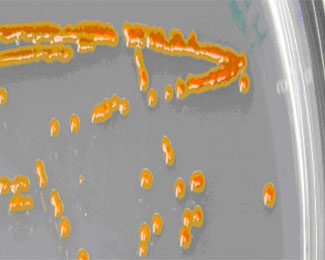Bacterial survival genes

The bacterium Polaribacter sp. MED 152 is a microorganism that belongs to the marine Bacteroidetes cluster, which represent the third major bacterioplankton group, after cyanobacteria and proteobacteria. However, despite its abundance in the sea, a genomic study of this group was still lacking.
Analysis of the MED152 genome has allowed on the one hand observing that it contains a substantial number of genes for attachment to surface particles, gliding motility, and polymer degradation. On the other hand, it contains the proteorhodopsin gene, together with a remarkable suite of genes related to light response. Proteorhodopsins are proteins with an associated pigment, which are able to generate energy from light; they have been discovered recently, but now it is known that they are widely distributed in the ocean.
SEM (Scanning Electron Microscopy) image showing individual Polaribacter sp. MED152 cells (Photo: I.Lekunberri and J.M. Fortuño)
Thus, the study of the genome of Polaribacter MED152 has been extremely helpful in generating hypotheses about the life strategies of this microorganism that can now be tested experimentally. The results suggest that the microorganism can alternate between two lifestyles. First, it is very well equipped to attach to surfaces, glide in search for food, and degrade it for carbon, nutrients, and energy. However, once suitable substrates have been exhausted, MED152 needs to find new particles to colonize. This forces the bacterium to carry on a free-living existence in a carbon-poor environment where it cannot move and where it is not prepared to use the compounds present in that medium. Somehow, the bacterium needs to survive and it seems to do it by using proteorhodopsin to capture light and generate energy under this situation.
These strategies for survival are completely different from what is known from other bacterial groups in the ocean. Therefore, the genome of Polaribacter will serve as a model to study the cellular and molecular processes in bacteria that have proteorhodopsin, their adaptation and their role in carbon-cycling in the sea.
References
Genome analysis of the proteorhodopsin-containing marine bacterium Polaribacter sp MED152 (Flavobacteria). Gonzalez, JM; Fernandez-Gomez, B; Fernandez-Guerra, A; Gomez-Consarnau, L; Sanchez, O; Coll-Llado, M; del Campo, J; Escudero, L; Rodriguez-Martinez, R; Alonso-Saez, L; Latasa, M; Paulsen, I; Nedashkovskaya, O; Lekunberri, I; Pinhassi, J; Pedros-Alio, C. PROCEEDINGS OF THE NATIONAL ACADEMY OF SCIENCES OF THE UNITED STATES OF AMERICA, 105 (25): 8724-8729 JUN 24 2008


